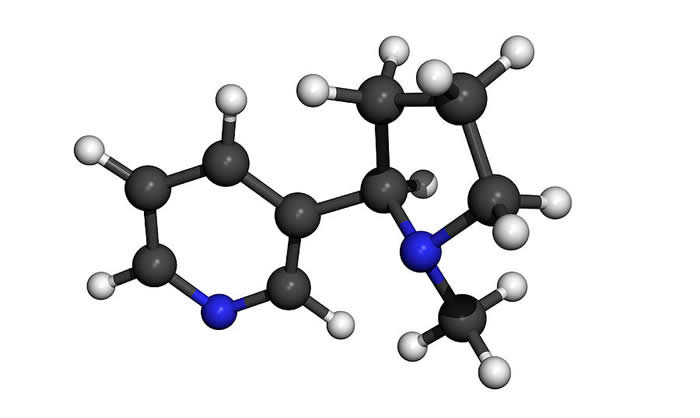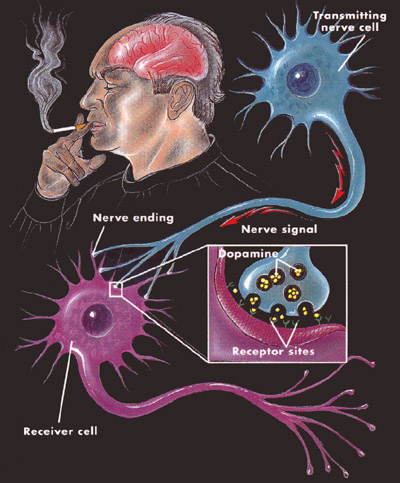Lesson 6: Nicotine Use Disorder
Attention
Produced by Cherokee Nation Healthy Nation, this video explains the sacredness of traditional tobacco and the fact that use of commercial tobacco is not sacred in Native American or Cherokee culture.
Click HERE to view this video directly on YouTube.
Learning Outcomes
Upon completion of this lesson's material, students will be able
- Understand how Tobacco Use Disorder helped to inspire the work of Prochaska and DiClemente
- Understand the concept of "self-medication" and how it affects tobacco users
- Be able to state how Tobacco Use Disorder reflects the limits of the Stages of Change model
- Understand how nicotine works to produce addiction
- Be able to state reasons why some addictive substances are legal and others are not
- Be able to discuss smoking cessation with MHRT/C clients and to assist them in cessation
Teaching
Reading
Chapters 4, 5, 6, and 7 in Nestor and Nutt
NICOTINE USE

Molecular Model of Nicotine
Nicotine Use Disorder: a model of how the Stages of Change take place. NUD treatment options.
- DSM 5 calls it Tobacco Use Disorder perhaps because nicotine replacement plays such an important role in treatment. But we will refer to it as Nicotine Use Disorder (NUD) because nicotine is the addictive substance and now with e-cigarettes, people are using nicotine without tobacco. Also calling it Tobacco Use Disorder would be like referring to alcohol addiction as "Wine Use Disorder" or "Beer Use Disorder".
- Tobacco first discovered after the European invasion of the Americas. Tobacco is a native product of the nightshade family like potatoes and tomatoes which were also unknown in Europe prior to Columbus. Tobacco was at first widely perceived as having healing properties perhaps because of native American beliefs. Smoking can be beneficial to some digestive problems (ulcerative colitis) but by-in-large tobacco use is responsible for more sickness and death than all other substances combined. But the perception of health benefits may be due to its stimulant qualities, improving concentration, memory and motor performance.
- Nicotine is a cholinergic receptor agonist. As such it can both increase muscle activity and activate the parasympathetic ANS producing relaxation. Nicotine is therefore the "renaissance drug" producing both stimulation and relaxation. Stimulation usually occurs at lower doses and relaxation at higher doses. Nicotine is very toxic. The average dose in a cigarette is 2mg. The LD50 dose in humans is just 40 to 60mg. Nicotine like many other substances produces other neurohumoral mediators as it works its way through the body. Most significant are epinephrine (adrenaline) which is similar to cocaine, amphetamine and caffeine, and dopamine, which is released in the limbic system and is the final common pathway of addiction.

Legal vs illegal Substances
- Currently legal: alcohol, tobacco, caffeine. Also dextromethorphan, diphenhydramine, nutmeg, morning glory seeds, glue, gasoline, nitrous oxide, poppers etc. etc.
- EROWID is a resource for understanding why people use substances. Look up nutmeg on Erowid and see why people use it to get high.
- DEA Schedule: Part of the Controlled Substances Act signed into law in 1970. The legislature ignored the suggestion of the Shafer commission to decriminalize marijuana and instead put it in Schedule 1 which prohibited any use, denying any medical or other efficacy. Legal drugs like tobacco, alcohol and caffeine are not scheduled or even subject to Food and Drug Administration oversight but rather are dealt with by the Alcohol Tobacco and Firearms agency. Recently there has been some effort to put nicotine under the oversight of the FDA
- Harrison Narcotics Act. Designed to regulate use of narcotics which had previously been freely available in the U.S. As with alcohol prohibition which came soon after, the Act was sold to improve the health and morals of the nation but the politics of the time traded on fears of use by drug crazed minorities.
- Marijuana Tax Act. Although it only taxed marijuana its effect was to result in self-incrimination under state and Federal Laws if the tax was payed. Supreme Court finally found it unconstitutional in 1969 but was immediately replaced by the Controlled Substances Act. The laws arguably were sold to legislators and to the public based on perception of harm greater than that of the legal substances alcohol and tobacco and the perception that use was largely confined to antisocial elements of despised minorities.
- Compared to other drugs, nicotine is by far the greatest threat to health. CDC - Fact Sheet - Tobacco-Related Mortality - Smoking & Tobacco Use Tobacco - American Lung Association
Tobacco use in Special Populations
Smoking rates vary from about 20% of the general U.S. population (down from about 50% in the 1950's). Smoking rates much higher for people with a substance use or mental illness diagnosis with 44% of U.S. consumption by this population. Rates vary by diagnosis with highest rates for Schizophrenia and Bipolar (50 to 70%) and for Alcohol Use Disorder (upwards of 85%). People with anxiety and depression smoke at about a 40% rate. Schizophrenics may be self-medicating the negative symptoms of schizophrenia (especially anhedonia, poor social interaction), while people with anxiety and depression look to the relaxing and stimulating effects of tobacco. Tobacco smoking may interact with alcohol to potentiate the effects of both.
CDC Features - Smoking Among Adults With Mental Illness
QUTTING SMOKING
Click the logo to visit the website for Tobacco-Free Maine
Trying to quit
- The Stages of Change Model was developed around helping people to stop smoking. The primary issue with any addiction but especially smoking which in many ways is the hardest to change is to raise consciousness of the pros and cons of continuing the habit. The appeal always is to "What's best for you?" trusting the person to sort that out for themselves This is the opposite of the confrontation techniques that were so widely used with addictions even a few years ago. Motivational Interviewing is used to help the person move from Precontemplation to Contemplation and the Interviewer rolls with the resistance rather than confronting it. MHRT/Cs can be especially helpful as trusted advocates for the client who consciously dedicate their work to helping the client actualize their full human potential. The MHRT/C as community support worker helps the client to plan improvements to their life while as case manager they help the client to marshal their resources.
- Even with Stages of Change and Motivational Interviewing only 50% of smokers succeed in quitting even with multiple attempts. Best advice is to "Keep on quitting!" but people grow discouraged because this addiction is so hard to overcome. The limits of Stages of Change is that it depends on resolution of ambivalence and strong motivation to make the needed efforts at change. These can be difficult for folks who have not had a lot of success in life and have had a lot of trouble. Also difficult for depressed people.
Medications that Can Help
Nicotine Replacement Therapies. The patch has been around since the 1960's and is the original medication assisted therapy. Like methadone and buprenorphine it is designed to reduce harm rather than to cure the addiction. The patch reduces harm by reducing exposure to tobacco carcinogens and also by changing dosing schedule from one controlled by desire to use by one controlled by steady release of nicotine: when this happens it is easier to eventually reduce and finally stop use altogether. So the patch starts with a dose equivalent to about a half pack a day and tapers down over several weeks. Nicotine now available also in gum, lozenges, puffers, nose spray and e-cigarettes (which are not FDA approved due to lack of research)
Zyban. This is Wellbutrin (bupropion) marketed for smoking cessation. Mechanism of action is unknown but may be related to release of epinephrine and dopamine in the limbic system.
Bupropion (Zyban) for Quitting Smoking
Chantix. A nicotine receptor blocker that makes the person feel like they have just had a cigarette. Reduces craving to the point where the person does not want to smoke. Is taken for 12 weeks and may produce quit rates as high as 40%
Treatment that Can Help
- Cognitive Behavioral Therapy. Helps the person learn new coping skills to maintain abstinence. Helps them to replace the habits of addiction (where they smoke, when they smoke, under what circumstances they smoke) with new habits that meet their need without the chemical. For example waking up to a brisk walk rather than a cigarette to get your body going. Relaxing with deep breaths rather than smoking.
- Support Groups . Not as successful with this population as with AA and NA. But social approval from friends and family can be powerful.
- Traditional attitude of AA towards smoking cessation has been negative discouraging alcoholics from trying to change too much at once. But increasingly research demonstrates that people who quit smoking at the same time they quit drinking are more successful in changing both habits, perhaps because the heavy association of smoking with drinking triggers cravings, perhaps because of general down regulation of the limbic system by stopping both chemicals
Assessment
Lesson 6 Quiz
- Describe one mental illness where a smoker may be self-medicating. What are the symptoms that are being medicated?
- List reasons why the Stages of Change Model may not work with smoking.
- List the neurohumoral mediators involved in tobacco use. What changes in the nervous system does each one make.
- List two factors influencing whether a substance is legal or illegal.
- What DEA schedule is cannabis in? How does this influence research? What DEA schedule is alcohol in? How does this influence research?
Lesson 6 Discussion
Describe how you as an MHRT/C could help a client who smokes and has emphysema. What is your likelihood of success in helping them achieve permanent abstinence and given this factor how might you change your approach?
Remember, you mist post TWICE in EVERY discussion board. Your first post should address the topic of the discussion (like the one above) and your second post must be a reply to ANOTHER students' post...your reply should be MORE than just a "I agree!" or "Very cool!" It should be "substantive" by expanding on the students post, asking a questions, adding your own thoughts to what they have said, etc.
